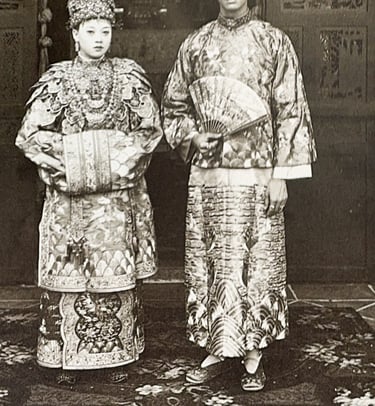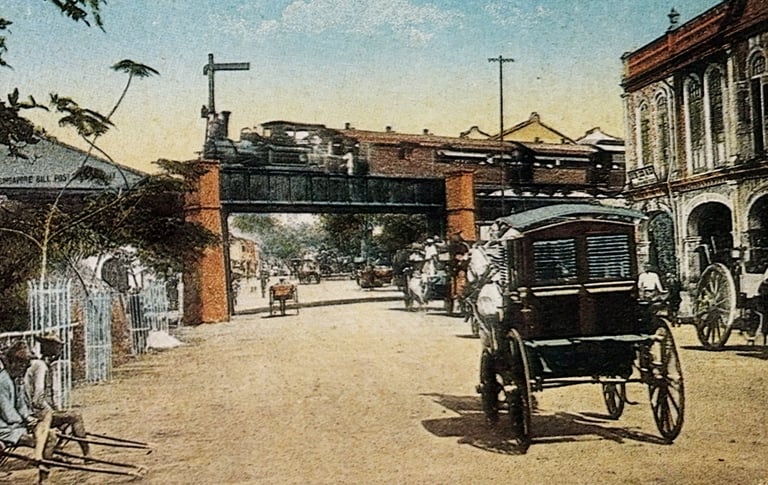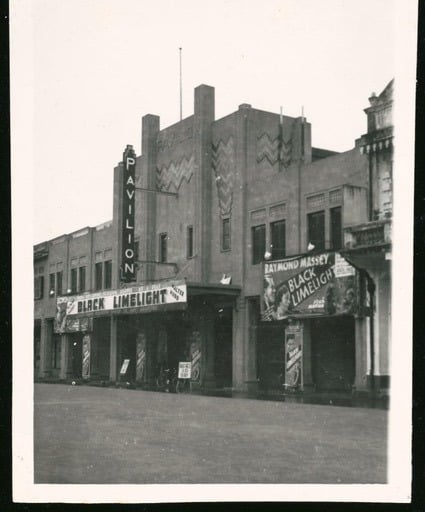An Enclave for wealthy local Chinese and Peranakans


In 1900, the Emerald Hill estate was purchased by local Chinese businessmen Seah Boon Kang and Seah Eng Kiat, who then carved up the land into smaller lots and sold them to individual owners who built the first terrace houses and shophouses at Emerald Hill.
Beginning in the early 1900s the earlier individual residences scattered on Emerald Hill were joined by a number of shophouses along the East side of Emerald Hill Road.
A railway bridge spanned across Orchard Road from the early 1900’s and served a line running between Emerald Hill and Cuppage Road.
This bridge was part of the Singapore-Kranji Railway that was opened in 1902 and linked Woodlands to a station at Tank Road. The railway stopped operating after Tanjong Pagar Railway Station opened in 1932. after which the bridge was subsequently removed.
Emerald Hill of the early 20th century soon became a residential enclave for wealthy local Chinese and Peranakan businessmen and their families. During this period, a typical Emerald Hill terrace house would cost about $3,000. It was a bustling place then, where many rickshaws and horse drawn carriages plied the roads.
In 1905 on the adjacent Cuppage Road, the banker Boey Lian Chin built 17 terrace houses. The Cold Storage Company opened the first supermarket in Singapore on Orchard Road between Emerald Hill and Cuppage Roads.
To the local residents, Emerald Hill Road became fondly known as tang leng tiam yia yee hang (“Tanglin Cinema Street” in Teochew). The cinema referred to the Pavilion Theatre that operated between 1914 and 1971 on Orchard Road opposite the intersection with Emerald Hill Road.
In 1921, the Municipal Commission agreed to convert Emerald Hill Road into a public street.
Between 1923 and 1925 a prominent Teochew businessman and developer, Low Koon Yee, built 32 luxury courtyard terrace houses on a large parcel of land located between Saunders and the west side of Emerald Hill Roads. This site is where Erin Lodge, one of William Cuppage’s residences, had been constructed in 1861, in the heart of his Nutmeg plantation.
This development was one of Singapore’s first landed residential planned enclaves and coupled with the earlier construction of the shophouses along the east side of Emerald Hill Road, became a location of choice for both full time and holiday residences, as well as businesses. The design and fitting out of these courtyard terrace residences was considered of the highest quality available, with the courtyards creating a sense of privacy and status for the owners – residents.
In 1925, the Singapore Chinese Girls’ School moved from Hill Street to the Orchard area, where its new $65,000 campus was located within the parcel of land bounded by Orchard Road, Emerald Hill Road, Cairnhill Road and Hullet Road (the Singapore Chinese Girls’ School remained in Emerald Hill until 1994).
In 1927, Hullet Road, a short street connecting Emerald Hill Road to Cairnhill Road, was properly paved and also declared a public street.
By the 1930s, Emerald Hill consisted of at least 112 houses, 45 of which were occupied by Peranakan families. Peranakans, also known as Straits Chinese or Babas, are the descendants of early Chinese immigrants who married locals and settled in Southeast Asia.
In 1937, Cairnhill Road was extended at its northern end to link up with Emerald Hill Road. The road extension was named Cairnhill Circle.
A HISTORY OF THE EMERALD HILL ESTATE, SINGAPORE






